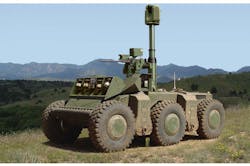We don’t have robots that can identify and kill the enemy on the front lines of today’s battlefields yet, but they aren’t that far off. The United States, China, Russia, Israel, South Korea, and the United Kingdom already use unmanned ground and aviation equipment with different levels of autonomy and destructive power.
In stark contrast, then, we have robosperm—or, more properly, the MagnetoSperm (Fig. 1). Measuring just 322 µm long, these robots have heads made of a cobalt-nickel layer that makes them miniscule magnetic torpedoes that can be steered throughout the human body to deliver drug therapy, clean blocked arteries, and perform in-vitro fertilization. Applications relative to nanotechnology also are possible.
This file type includes high resolution graphics and schematics when applicable.
Lethal Robots
The United Nations has held multi-national talks in Geneva to debate lethal autonomous weapons systems. Before those meetings, the Campaign to Stop Killer Robots said that the world’s nations should agree to draft international laws to stop the development of what it calls killer robots—in other words, weapons that can select and engage targets without human intervention once activated.
But are these meritorious talks too late? Will governments really sign a pledge not to halt the development of autonomous weapons of war? Possibly, and no.
In the U.S., the Defense Advanced Research Projects Agency (DARPA) has made significant progress with the Crusher, a 6000-kg autonomous multi-terrain unmanned combat vehicle (Fig. 2). Also, the U.K. has successfully tested the Taranis, an unmanned intercontinental aircraft that can operate without human supervision (Fig. 3).
Named after the Celtic god of thunder, the £145 million Taranis can fly faster than the speed of sound and select targets automatically. It only seeks authorization from a human controller when it needs to attack a target. The combat aircraft made its maiden flight earlier this year.
One Member of Parliament in the U.K., Nia Griffith, has suggested that such robotic technology would create a legal vacuum and could create mayhem in theatres of war if they malfunctioned or were hacked, changing their target objectives.
Opposition to military robots has considerable support. Twenty Nobel Peace laureates, including Jody Williams, a founding member of the Campaign to Stop Killer Robots, have issued a statement expressing their support for a preemptive ban on fully autonomous weapons, noting that lethal robots would completely and forever change the face of war and likely spawn a new arms race.
Williams is urging an outright ban on autonomous robots, which the U.S. Pentagon defines as weapons that “once activated, can select and engage targets without further intervention by a human operator.”
No government has opposed discussing questions about such weapons in 2014. However, many governments remain ambiguous about how they would address the issue.
The U.K.’s Foreign Office, for example, has told Amnesty International by letter that while it was “committed to upholding international humanitarian law,” it would not commit to a course of action that might deny the Armed Forces “legitimate and effective capabilities.”
It went on to say that the technology represents a “step on” from drones used in Afghanistan because the robots can automatically select and kill targets. Furthermore, the U.K. said it would not join the U.N. in calling for an outright ban on the technology because a human being should always oversee it.
There is absolutely not doubt that human management of autonomous war machines is imperative. But perhaps a crucial concern is how we make sure the right person is in control.
Robots That Save Lives
Humans also will play a key role when it comes to controlling the MagnetoSperm. When the robot sperm is subjected to a magnetic field of about the same strength of a refrigerator magnet, it experiences a magnetic torque on its head, which causes its tail to spin and propels it forward (Fig. 4).
Humans then can steer the robosperm by directing the magnetic field lines towards its destination. This method of propulsion was a key area of research for the scientists at the University of Twente in the Netherlands and the German University in Cairo. It is designed to replicate the motion of a human sperm.
Magnetic and electromagnetic micro-robots have been an important area of research for some years. But the robots’ inability to travel far has been a challenge. The team came up with flagella as a solution. These complex biological cell structures act almost like an internal motor.
From the Latin for “whip,” the flagellum propels sperm forward in liquid. For the robotic sperm, these flagellum have been generated as a combination of flexible and rigid helical structures that respond to oscillating and rotating magnetic fields.
The micro-robot is created by spin-coating onto a silicon support wafer a 5-µm layer of SU-8, a polymer. The cobalt-nickel layer is then added to the head via electron beam evaporation.
The MagnetoSperm can swim at speeds of up to 0.5 body lengths per second, but the University of Twente and the German University in Cairo don’t want to stop there. Research is continuing to make the robosperm smaller, and the team is currently working on a method to generate a magnetic nanofibre that can be used as a flagellum. This could possibly produce robosperm of such microscopic proportions that even human cell sorting applications would be possible.





